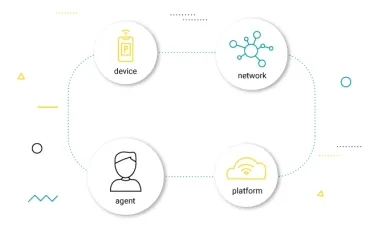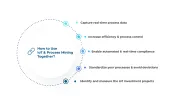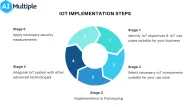A 2024 Guide to IoT Ecosystem: 5 Components & 3 Challenges


IoT ecosystem is the interconnected network of devices collecting, exchanging, gathering, and sharing data onto the cloud or on a physical database.
In this article, we will have an in-depth overview of each of the five components of making up an ecosystem and also mention some challenges pertaining to establishing one for your business.
What are the 5 main components of an IoT ecosystem?
There are five main components that make for an IoT ecosystem, including:
IoT devices
Two necessary conditions need to be met for a device to be designated as an IoT device:
- The device has to connect to the Internet.
- It should leverage sensors, a software, or any related technology to connect with other devices as well.
If these two conditions are present, then we have an IoT device that is ready to be integrated into a larger ecosystem by connecting with other devices.
A common example of an IoT device is an Apple watch, capable of both connecting to the internet and an iPhone alike, constantly exchanging information.
But any object, theoretically, could be an IoT device. A wooden chair can be embedded with a chip to gather and relay the sitter’s data (e.g. his weight, duration of sitting, etc.) onto a database via the internet.
Advice for IT leaders: To establish an IoT ecosystem you should first start with using devices that meet these two requirements.
IoT communication protocol
IoT devices connect with one another, and to the cloud, through IoT communication protocols, such as Bluetooth, NFC, cellular networks, Zigbee, among other networks.
Advice for IT leaders: Choose the best communication protocol for your IoT ecosystem depending on:
- The amount of data you need to exchange,
- Placement range of your devices,
- The power consumption of your devices,
- And the overall budget available at your disposal.
IoT cloud
IoT cloud is an extensive internet-based network that stores data from IoT devices and applications.
Through embedded sensors and trackers, IoT devices collect data. The data is then transferred to a data center, known as the cloud for non-premise held servers, where all other IoT devices’ data are also stored.
The user then has access to the data gathered from numerous devices in one convenient location, in order to perform tasks such as visualizations and analytics.
Advice for IT leaders: Use the cloud if all employees, from anywhere in the world, need to connect to it and access its content.
IoT monitoring
IoT devices, protocols, and the cloud need constant monitoring to fill in performance gaps, ensure optimal functionality, and troubleshoot outages. Without round-the-clock IoT monitoring, IoT non-functionality might go unnoticed until it’s too late.
IoT monitoring involves establishing performance thresholds and KPIs, whereby the monitoring software applications preemptively alert the IT department if there are performance issues.
Advice for IT leaders: Invest in IoT monitoring tools such as Splunk Industrial for IoT and SkySpark to help you keep track of your devices’ constant functionality.
IoT users
Users are an essential part of the ecosystem, be it the developers setting them up, the employees using it, or the business owners reaping the benefits of their potential.
Agents and machines in this ecosystem complement each other, as the data is rendered useless without shrewd utilization, and there is no actionable insight without the presence of data.
Advice to IT leaders: Hire employees by investigating their experience and expertise in the domain of IoT.
What are the main challenges of implementing an IoT ecosystem?
In the current climate, not implementing an IoT ecosystem would create economical and administrative inefficiencies in organizations. But that is not to say that adopting an IoT ecosystem will be easy or without its issues. The following are the main challenges executives and IT leaders face when implementing an IoT ecosystem:
1. ROI
Accurately calculating the ROI of implementing an IoT ecosystem can be challenging and off-putting for business executives.
Advice for executives: Instead of solely focusing on how much it costs to establish an IoT ecosystem, focus on calculating the lasting revenue an IoT ecosystem would bring in for you. Then compare that with a counterfactual scenario of not implementing one at all. This will make the ROI more clear.
2. Employee training
Asking your employee to suddenly change track and use a digital, rather than a physical, framework can increase the chances of your ecosystem falling apart.
Advice for executives: Prioritize communication, leadership, and ongoing training. For instance, transferring on-premise data servers onto the cloud takes time and effort. And so will readying the employees for the new way of doing business. This is why it’s good to conduct a survey about the level of readiness of your employees in transitioning to an online environment. This will help identify digital core deficiencies and prepare the workforce for the changing job requirement.
3. Cybersecurity vulnerabilities
One digital device connected to the Internet is vulnerable to cyberattacks, let alone an extended network of them. As long as the Internet exists, cybersecurity is a challenge for everyone and everything. IoT increases the attack surface.
Advice for IT leaders:
- Start with the prevention of attacks and make it as difficult as possible for attackers to get in.
- Apply new principles like “zero trust” to control and verify all actors in the network as well as every data stream to prevent disruptions before they occur.
- Invest in cybersecurity tools and protocols and familiarize yourself with your network’s access points.
- Conduct a survey of the level of readiness of your employees in transitioning to an online environment. This will help identify digital core deficiencies and prepare the workforce for the changing job requirement.
For more on the internet of things
To learn more about the internet of things’ technical side, read:
- A Deep Dive into IoT Architecture & Top 10 Components
- IoT-5G For a Fast and Consistent Connectivity
- IoT Testing: Framework, Challenges, Case studies & Tools
Finally, If you believe your business will benefit from an IoT solution or device, feel free to check our data-driven hub of IoT solutions and tools.
And we can guide to through the process:

Cem is the principal analyst at AIMultiple since 2017. AIMultiple informs hundreds of thousands of businesses (as per Similarweb) including 60% of Fortune 500 every month.
Cem's work has been cited by leading global publications including Business Insider, Forbes, Washington Post, global firms like Deloitte, HPE, NGOs like World Economic Forum and supranational organizations like European Commission. You can see more reputable companies and media that referenced AIMultiple.
Throughout his career, Cem served as a tech consultant, tech buyer and tech entrepreneur. He advised enterprises on their technology decisions at McKinsey & Company and Altman Solon for more than a decade. He also published a McKinsey report on digitalization.
He led technology strategy and procurement of a telco while reporting to the CEO. He has also led commercial growth of deep tech company Hypatos that reached a 7 digit annual recurring revenue and a 9 digit valuation from 0 within 2 years. Cem's work in Hypatos was covered by leading technology publications like TechCrunch and Business Insider.
Cem regularly speaks at international technology conferences. He graduated from Bogazici University as a computer engineer and holds an MBA from Columbia Business School.
Sources:
AIMultiple.com Traffic Analytics, Ranking & Audience, Similarweb.
Why Microsoft, IBM, and Google Are Ramping up Efforts on AI Ethics, Business Insider.
Microsoft invests $1 billion in OpenAI to pursue artificial intelligence that’s smarter than we are, Washington Post.
Data management barriers to AI success, Deloitte.
Empowering AI Leadership: AI C-Suite Toolkit, World Economic Forum.
Science, Research and Innovation Performance of the EU, European Commission.
Public-sector digitization: The trillion-dollar challenge, McKinsey & Company.
Hypatos gets $11.8M for a deep learning approach to document processing, TechCrunch.
We got an exclusive look at the pitch deck AI startup Hypatos used to raise $11 million, Business Insider.
To stay up-to-date on B2B tech & accelerate your enterprise:
Follow on


Comments
Your email address will not be published. All fields are required.